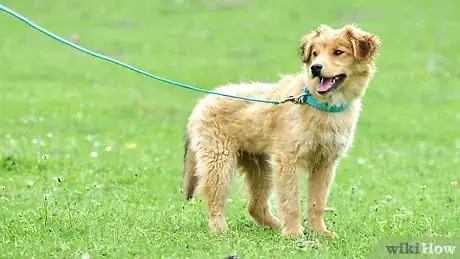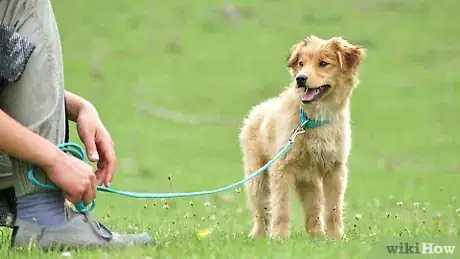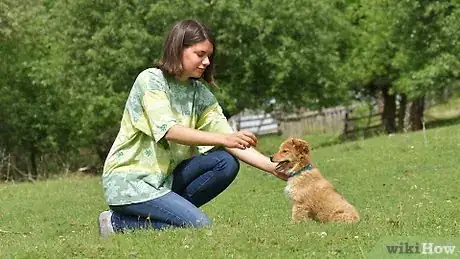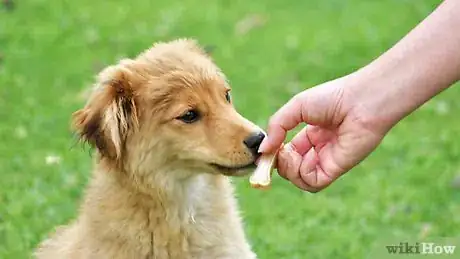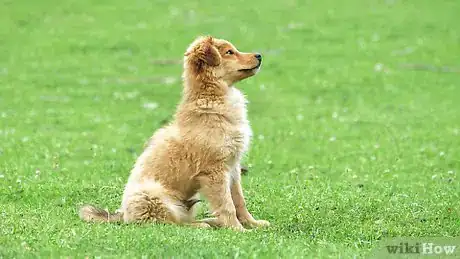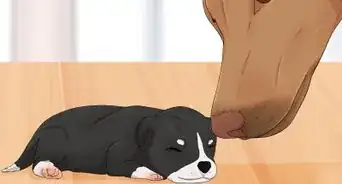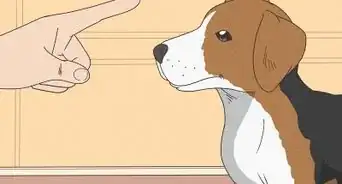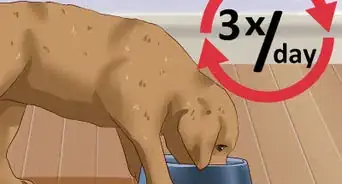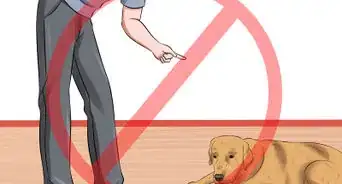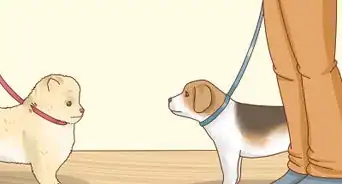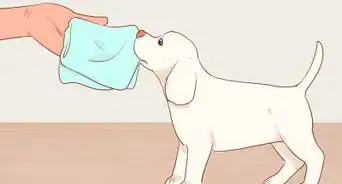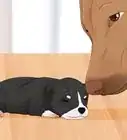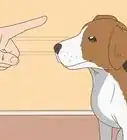This article was co-authored by Brian Bourquin, DVM. Brian Bourquin, better known as “Dr. B” to his clients, is a Veterinarian and the Owner of Boston Veterinary Clinic, a pet health care and veterinary clinic with three locations, South End/Bay Village, the Seaport, and Brookline, Massachusetts. Boston Veterinary Clinic specializes in primary veterinary care, including wellness and preventative care, sick and emergency care, soft-tissue surgery, dentistry. The clinic also provides specialty services in behavior, nutrition, and alternative pain management therapies using acupuncture, and therapeutic laser treatments. Boston Veterinary Clinic is an AAHA (American Animal Hospital Association) accredited hospital and Boston’s first Fear Free Certified Clinic. Brian has over 19 years of veterinary experience and earned his Doctor of Veterinary Medicine from Cornell University.
This article has been viewed 16,825 times.
When you are raising a puppy it's important to teach it to come when called. This command can make handling the puppy easier and will allow you to control your puppy's actions. The good news is that teaching a puppy to come is typically a straightforward process. With some basic training and repetition, you will be able to teach your puppy to come when called.
Steps
Completing Training Preparations
-
1Teach your puppy its name. In order to teach your puppy to come, it's a good idea to first teach it its name. Having its name established in the puppy's mind will allow it to better understand when you are calling it.[1]
- It's important to use the dog's name in a positive manner while training it. For instance, say "you are a good dog Spot" while you are petting it. Using its name to punish or reprimand it, such as saying "bad Spot," can make the dog hesitant to respond to it.
-
2Make time for training every day. The key to successful training of any kind is repetition. Making time to train every day will ingrain in the puppy that this is an important job you are doing. The puppy is also more likely to remember what it is supposed to do if you repeat the training session several times every day.[2]
- Your daily training sessions do not have to be long. Setting aside 15 minutes every day for training is typically enough for a puppy.
- Daily training sessions are a great way to bond with a new dog, in addition to getting it trained properly.
- Take advantage of unplanned actions, such as when the puppy runs to you because it wants to play. Label this as "come" by saying the word as the puppy starts running towards you, and then praise it.
Advertisement -
3Make training sessions 10 to 15 minutes long. Puppies do not have long attention spans. They can focus and learn in short bursts but will not pay attention for long stretches of time. With this in mind, make training sessions about 10 to 15 minutes and then let the puppy go do what it wants to do.[3]
- Short bursts of training also minimizes the chance of you getting frustrated with your puppy when it doesn't respond to your commands. Acting frustrated and angry at your puppy can actually set back training, so you want to avoid that at all costs.
- End each session on a positive note by saying a command that the puppy knows, and then giving the puppy a reward for responding to the command correctly.
-
4Find the right reward. Dogs can be motivated by a variety of things, including praise, affection, toys, or treats. Figure out what motivates your puppy the most and use that in your training sessions.[4]
-
5Remove distractions before you begin training. In order to have a successful training session with a puppy you need to find a way to make it focus on you. Locating your training session in an area with no other dogs, toys, or other distractions will go a long ways toward your puppy focusing on you.[5]
- With a small puppy, you can typically just use a large space in your home or your yard.
Teaching Recall With the Puppy on a Leash
-
1Begin training with the puppy on a leash. You want to begin training with some control over your puppy's movements. With it on leash you will be able to keep the puppy focused on training and you won't have to continually chase it down.[6]
- You will not be pulling the puppy by the leash. The leash is simply there to keep the puppy focused on what you are doing.
-
2Call the puppy by name until it comes towards you. To get the puppy to come towards you, use a friendly and excited voice. Call it by name and use the word "come." You can also motion with your hands so that that motion is also connected to recall.[7]
- It's important to use friendly voice that the puppy will respond positively to.
- If you are too loud or boisterous, the puppy may get frightened and resist coming to you.
-
3Give physical and verbal praise. Once the puppy comes to you, show it that you are so happy it came. Give it a long pet and tell it that it did a good job. Say "good job" and praise it repeatedly.[8]
- Establishing the connection in your puppy's mind between physical and verbal praise and the action of coming to you is the key to getting your dog to come when called.
-
4Progress to training off leash. After your puppy has begun to come when called on a consistent basis, you can move to training off leash. Continue to put the puppy in a quiet area with few distractions but let it off leash. Get its attention by squeaking a toy and calling its name and then tell it to "come."
- The change from on leash to off leash can be a big adjustment for a puppy. Be prepared that the puppy may not respond to your commands right away under these new conditions.
-
5Make most of training opportunities when they arise. Not all of your training has to be in strict sessions. As the puppy is starting to get the hang of the command, incorporate the command into everyday situations.
- For example, whenever the puppy happens to move towards you, slap your thighs and say "come." Then reward the puppy when it comes running.
- At meal times, say "come" as the puppy runs over to its food. This will help the puppy link the word “come” with both running towards you and good things.
- Try making the command into a game. Run away from the puppy while slapping your thighs and saying "come."
Reinforcing Your Training
-
1Continue training sessions as your puppy grows. In order to keep the dog's recall consistent, it's important to continue training. Use the come command daily and do quick focused training sessions regularly. [9]
- If you are doing other training, you can add the come command into a mix of commands you are practicing.
-
2Work recall into games and daily activities. As your puppy grows and continues to learn you can make recall activities fun. Work the puppy's skills into games of fetch and use them on daily walks.[10]
- For example, you can work on recall when walking the puppy. Stop your walk for a moment and wait for the puppy to look at you. Start walking backwards and call the dog. Keep moving backwards until the slack in the leash is gone. As the puppy moves toward you, keep moving backwards. Don't stop moving until the puppy gets to you and then give it praise.
-
3Consider using more advanced methods of training. After your dog learns basic commands and is no longer a puppy, you can begin doing more advanced training. Consider using clicker training and/or a long-line at this point.
Expert Q&A
-
QuestionWhat do you do when your puppy won't come?
 Brian Bourquin, DVMBrian Bourquin, better known as “Dr. B” to his clients, is a Veterinarian and the Owner of Boston Veterinary Clinic, a pet health care and veterinary clinic with three locations, South End/Bay Village, the Seaport, and Brookline, Massachusetts. Boston Veterinary Clinic specializes in primary veterinary care, including wellness and preventative care, sick and emergency care, soft-tissue surgery, dentistry. The clinic also provides specialty services in behavior, nutrition, and alternative pain management therapies using acupuncture, and therapeutic laser treatments. Boston Veterinary Clinic is an AAHA (American Animal Hospital Association) accredited hospital and Boston’s first Fear Free Certified Clinic. Brian has over 19 years of veterinary experience and earned his Doctor of Veterinary Medicine from Cornell University.
Brian Bourquin, DVMBrian Bourquin, better known as “Dr. B” to his clients, is a Veterinarian and the Owner of Boston Veterinary Clinic, a pet health care and veterinary clinic with three locations, South End/Bay Village, the Seaport, and Brookline, Massachusetts. Boston Veterinary Clinic specializes in primary veterinary care, including wellness and preventative care, sick and emergency care, soft-tissue surgery, dentistry. The clinic also provides specialty services in behavior, nutrition, and alternative pain management therapies using acupuncture, and therapeutic laser treatments. Boston Veterinary Clinic is an AAHA (American Animal Hospital Association) accredited hospital and Boston’s first Fear Free Certified Clinic. Brian has over 19 years of veterinary experience and earned his Doctor of Veterinary Medicine from Cornell University.
Veterinarian If you have a particularly hyper or wild puppy, you may need to use a healthy treat to get it to respond to your commands. However, most puppies are plenty motivated by your praise and attention.
If you have a particularly hyper or wild puppy, you may need to use a healthy treat to get it to respond to your commands. However, most puppies are plenty motivated by your praise and attention.
References
- ↑ http://www.akc.org/content/dog-training/articles/teach-dog-to-come-when-called/
- ↑ https://vcahospitals.com/know-your-pet/puppy-behavior-and-training-training-basics
- ↑ https://vcahospitals.com/know-your-pet/puppy-behavior-and-training-training-basics
- ↑ http://www.akc.org/content/news/articles/training-dog-reward-obedience-commands/
- ↑ http://www.akc.org/content/dog-training/articles/teach-dog-to-come-when-called/
- ↑ http://www.peteducation.com/article.cfm?c=21+1276&aid=154
- ↑ http://www.humanesociety.org/animals/dogs/tips/teaching_come_command.html
- ↑ http://www.humanesociety.org/animals/dogs/tips/teaching_come_command.html
- ↑ http://www.akc.org/content/dog-training/articles/teach-dog-to-come-when-called/
About This Article
To teach a puppy to come, start by putting it on a leash so you have some control of its movements. Then, say “come” followed by your puppy’s name in an excited voice. As soon as it moves towards you, give it verbal praise by saying “Good dog,” or a reward, such as a toy or a treat. Once your puppy learns to respond, try the exercise without the leash. Additionally, make time for 10-15 minutes of training each day so your puppy gets used to the activity. For tips from our Veterinary co-author on how to train your puppy while playing games, read on!

